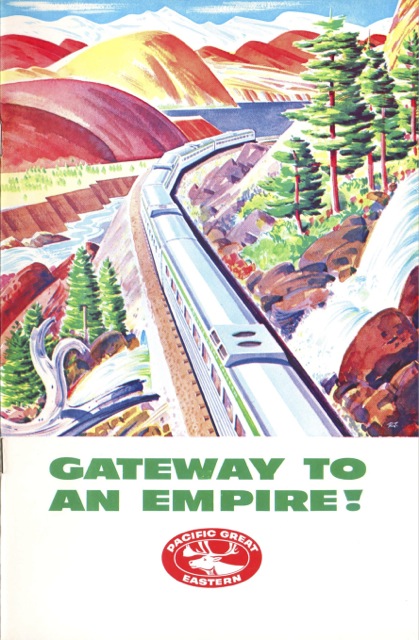The Pacific Great Eastern Railway started construction in 1912 with the aim of connecting Vancouver with Prince George, a town on the Grand Trunk Pacific route to Prince Rupert. Along with the Grand Trunk Pacific, the PGE railway failed long before reaching Prince George. Though it was taken over by the British Columbia provincial government in 1919, it did not reach Prince George until 1952.
 Click image to download an 8.0-MB PDF of this brochure.
Click image to download an 8.0-MB PDF of this brochure.
After that, things began to pick up, as described in this 16-page booklet: “Car loadings handled by the Pacific Great Eastern Railway soared from 12,482 in 1951 to more than 38,809 in 1957,” says the booklet, from which we can guess that the booklet was published in 1958. By this time, the railroad had acquired seven Budd RDCs and ran them between North Vancouver and Prince George as a train sometimes called the Caribou Prospector and sometimes the Caribou Dayliner.
This booklet is profusely illustrated with color paintings by Ronald Jackson, a fine artist best known for his paintings of British Columbia marine scenes such as Canadian Pacific’s Empress of Japan in Vancouver harbor. Born in Manitoba in 1902, Jackson received his art schooling in London and spent most of his professional life in B.C. He also painted commercially for the Vancouver Tourist Association and various government agencies.
Pacific Great Eastern took its peculiar name from the fact that many of its original, 1912 investors were involved in the English Great Eastern Railway. Sixty years later, and more than 50 years after government takeover, the BC government changed the name of the railway to BC Rail. In 2004, the government sold the railway to Canadian National in a sale (including a long-term lease of the right of way) that Canadian Pacific described as “rigged” as CN was given access to secret government documents about the value of the railroad that other bidders did not have.

There are several hints about the date in the booklet, with the PGE referring to Alaska as the newest and 49th US state. That happened in 1959, so the booklet must have been printed in 1959 or later. Contrary to the optimistic language in the booklet, the only reason why PGE survived was having its debts to the BC government forgiven – twice. Railgate, the 2004 sale scandal, is just one in the long history of PGE/BC Rail.
Jim